方位介词
- 格式:doc
- 大小:56.50 KB
- 文档页数:8
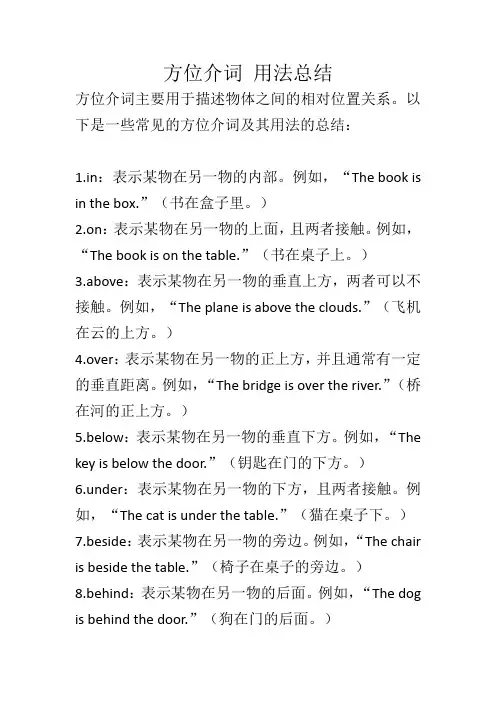
方位介词用法总结方位介词主要用于描述物体之间的相对位置关系。
以下是一些常见的方位介词及其用法的总结:1.in:表示某物在另一物的内部。
例如,“The book is in the box.”(书在盒子里。
)2.on:表示某物在另一物的上面,且两者接触。
例如,“The book is on the table.”(书在桌子上。
)3.above:表示某物在另一物的垂直上方,两者可以不接触。
例如,“The plane is above the clouds.”(飞机在云的上方。
)4.over:表示某物在另一物的正上方,并且通常有一定的垂直距离。
例如,“The bridge is over the river.”(桥在河的正上方。
)5.below:表示某物在另一物的垂直下方。
例如,“The key is below the door.”(钥匙在门的下方。
)6.under:表示某物在另一物的下方,且两者接触。
例如,“The cat is under the table.”(猫在桌子下。
)7.beside:表示某物在另一物的旁边。
例如,“The chair is beside the table.”(椅子在桌子的旁边。
)8.behind:表示某物在另一物的后面。
例如,“The dog is behind the door.”(狗在门的后面。
)9.in front of:表示某物在另一物的前面。
例如,“The car is in front of the house.”(车在房子的前面。
)10.between:表示某物在两者之间。
例如,“The apple is between the two oranges.”(苹果在两个橙子之间。
)请注意,这些方位介词有时会根据语境和具体的物体有所变化,以上总结仅为一般性的用法。
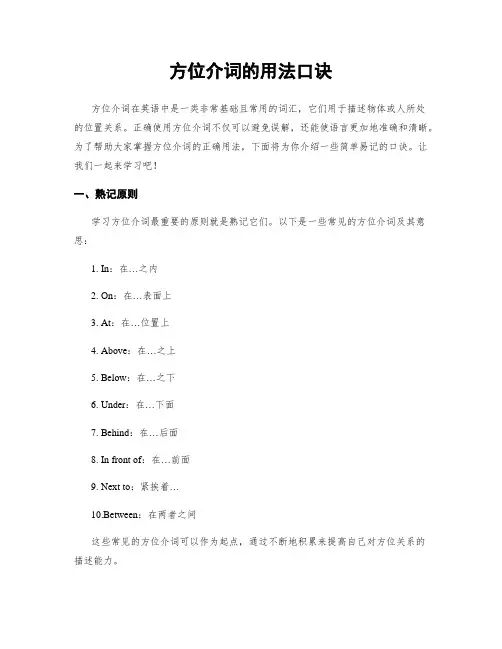
方位介词的用法口诀方位介词在英语中是一类非常基础且常用的词汇,它们用于描述物体或人所处的位置关系。
正确使用方位介词不仅可以避免误解,还能使语言更加地准确和清晰。
为了帮助大家掌握方位介词的正确用法,下面将为你介绍一些简单易记的口诀。
让我们一起来学习吧!一、熟记原则学习方位介词最重要的原则就是熟记它们。
以下是一些常见的方位介词及其意思:1. In:在…之内2. On:在…表面上3. At:在…位置上4. Above:在…之上5. Below:在…之下6. Under:在…下面7. Behind:在…后面8. In front of:在…前面9. Next to:紧挨着…10.Between:在两者之间这些常见的方位介词可以作为起点,通过不断地积累来提高自己对方位关系的描述能力。
二、空间位置接下来,我们将详细介绍每个方位介词所表示的具体空间位置。
1. In例句: The cat is in the box.翻译: 猫在盒子里。
这里的"in"表示一个物体完整地被包含在另一个物体之内。
2. On例句: The book is on the table.翻译: 书在桌子上。
"On"指的是一个物体位于另一物体的表面,而不是内部。
3. At例句: The meeting is at the conference room.翻译: 会议在会议室举行。
"At"用于表示某个具体位置,通常指特定的建筑物或地点。
4. Above例句: The bird is flying above the clouds.翻译:鸟儿在云层之上飞翔。
"Above"表示一个物体位于另一物体的上方,不接触其表面。
5. Below例句: The fish is swimming below the water surface.翻译:鱼儿在水面下游动。
"Below"则相反,表示一个物体位于另一物体的下方,也不接触其表面。
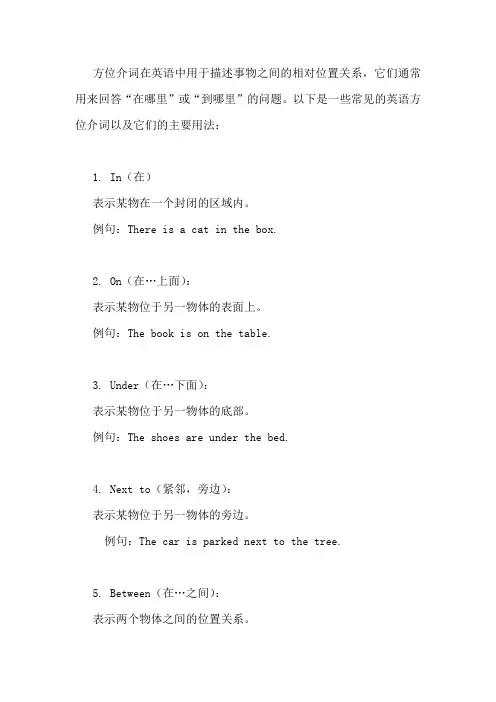
方位介词在英语中用于描述事物之间的相对位置关系,它们通常用来回答“在哪里”或“到哪里”的问题。
以下是一些常见的英语方位介词以及它们的主要用法:1.“In(在)表示某物在一个封闭的区域内。
例句:There“is“a“cat“in“the“box.2.“On(在…上面):表示某物位于另一物体的表面上。
例句:The“book“is“on“the“table.3.“Under(在…下面):表示某物位于另一物体的底部。
例句:The“shoes“are“under“the“bed.4.“Next“to(紧邻,旁边):表示某物位于另一物体的旁边。
““例句:The“car“is“parked“next“to“the“tree.5.“Between(在…之间):表示两个物体之间的位置关系。
例句:The“library“is“between“the“school“and“the“park.6.“Behind(在…后面):表示某物位于另一物体的背后。
例句:The“sun“sets“behind“the“mountains.7.“In“front“of(在…前面):表示某物位于另一物体的前面。
例句:There“is“a“garden“in“front“of“the“house.8.“Among(在…之中):表示某物位于一群物体中。
例句:She“found“her“keys“among“the“books.9.“Above(在…上方):表示某物位于另一物体的上方。
例句:The“bird“is“flying“above“the“clouds.10.“Below(在…下方):表示某物位于另一物体的下方。
例句:The“fish“are“swimming“below“the“surface.11.“In“the“middle“of(在…中间):表示某物位于另一物体的中间。
例句:The“restaurant“is“in“the“middle“of“the“street.12.“On“top“of(在…顶部):表示某物位于另一物体的顶部。
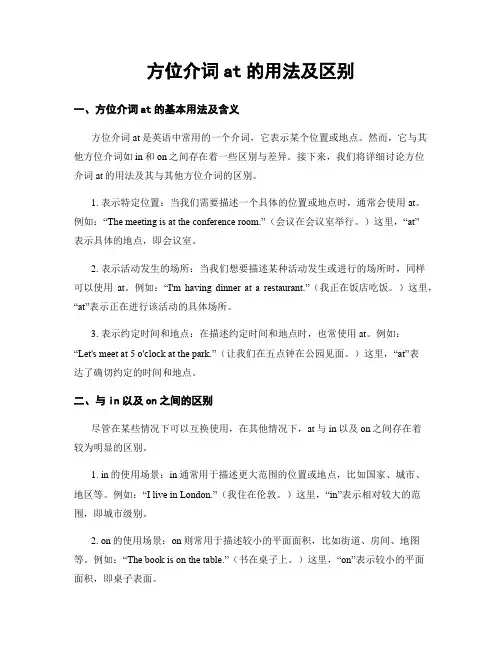
方位介词at的用法及区别一、方位介词at的基本用法及含义方位介词at是英语中常用的一个介词,它表示某个位置或地点。
然而,它与其他方位介词如in和on之间存在着一些区别与差异。
接下来,我们将详细讨论方位介词at的用法及其与其他方位介词的区别。
1. 表示特定位置:当我们需要描述一个具体的位置或地点时,通常会使用at。
例如:“The meeting is at the conference room.”(会议在会议室举行。
)这里,“at”表示具体的地点,即会议室。
2. 表示活动发生的场所:当我们想要描述某种活动发生或进行的场所时,同样可以使用at。
例如:“I'm having dinner at a restaurant.”(我正在饭店吃饭。
)这里,“at”表示正在进行该活动的具体场所。
3. 表示约定时间和地点:在描述约定时间和地点时,也常使用at。
例如:“Let's meet at 5 o'clock at the park.”(让我们在五点钟在公园见面。
)这里,“at”表达了确切约定的时间和地点。
二、与in以及on之间的区别尽管在某些情况下可以互换使用,在其他情况下,at与in以及on之间存在着较为明显的区别。
1. in的使用场景:in通常用于描述更大范围的位置或地点,比如国家、城市、地区等。
例如:“I live in London.”(我住在伦敦。
)这里,“in”表示相对较大的范围,即城市级别。
2. on的使用场景:on则常用于描述较小的平面面积,比如街道、房间、地图等。
例如:“The book is on the table.”(书在桌子上。
)这里,“on”表示较小的平面面积,即桌子表面。
3. 时间概念上的区别:at通常用于具体时间点上,例如“at 9 o'clock”;而in则表示某段时间内,在之后或过去,例如“in a week”,“in the morning”;而on则表示某个具体日期或星期几,例如“on Monday”,“on January 1st”。
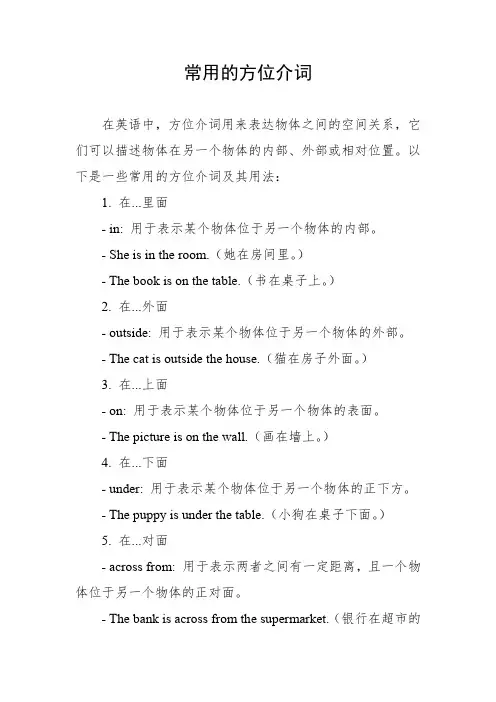
常用的方位介词在英语中,方位介词用来表达物体之间的空间关系,它们可以描述物体在另一个物体的内部、外部或相对位置。
以下是一些常用的方位介词及其用法:1. 在...里面- in: 用于表示某个物体位于另一个物体的内部。
- She is in the room.(她在房间里。
)- The book is on the table.(书在桌子上。
)2. 在...外面- outside: 用于表示某个物体位于另一个物体的外部。
- The cat is outside the house.(猫在房子外面。
)3. 在...上面- on: 用于表示某个物体位于另一个物体的表面。
- The picture is on the wall.(画在墙上。
)4. 在...下面- under: 用于表示某个物体位于另一个物体的正下方。
- The puppy is under the table.(小狗在桌子下面。
)5. 在...对面- across from: 用于表示两者之间有一定距离,且一个物体位于另一个物体的正对面。
- The bank is across from the supermarket.(银行在超市的对面。
)6. 在...旁边- beside/by: 用于表示两者紧挨着。
- The lamp is beside the bed.(灯在床旁边。
)7. 在...中间- in the middle of: 用于表示某个物体位于两个或多个物体的中间。
- There is a tree in the middle of the park.(公园中间有棵树。
)8. 在...之上/之上方-above: 用于表示某个物体位于另一个物体的上方,但不一定接触。
- The airplane is flying above the clouds.(飞机在云之上飞行。
)9. 在...之下/下方-below: 用于表示某个物体位于另一个物体的下方,但不一定接触。
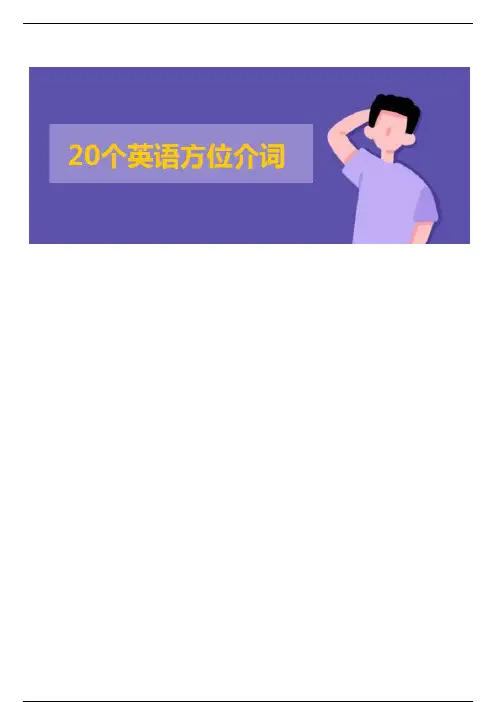
20个英语方位方位介词:in、on、over、under、above、below、by、beside、near 、next to、behind、before、outside、from、among、between等等。
—— 20个英语方位介词及释义 ——方位介词(1):in释义:在……之内例句:The students are reading in the classroom.学生们在教室里读书。
方位介词(2):on释义:在……上面例句:The boat is on the river.那条船在河上。
方位介词(3):over释义:在……(正)上方例句:There are several bridges over the river. 河上有好几座桥。
方位介词(4):under释义:在……(正)下方例句:The boat sailed under the bridge.船在桥下行驶。
方位介词(5):above释义:在……上方例句:The plane flew above the clouds.飞机在云上飞行。
方位介词(6):below释义:在……下方例句:The sun sinks below the horizon.太阳沉没在地平线下。
方位介词(7):by释义:在……旁边例句:Our house is by the river.我们的房子在河边。
方位介词(8):beside释义:Come and sit beside me.过来坐在我旁边。
方位介词(9):near释义:在……附近例句:Idon’t need a car becauseIlive nearthecity centre .我不需要汽车,因为我住在靠近市中心方位介词(10):next to释义:紧挨……例句:My best friend sits next to me in class.上课时我最好的朋友坐在我的旁边。
方位介词(11):behind释义:在……后面例句:Olive hid behind a tree.奥列弗藏在一棵树后面。
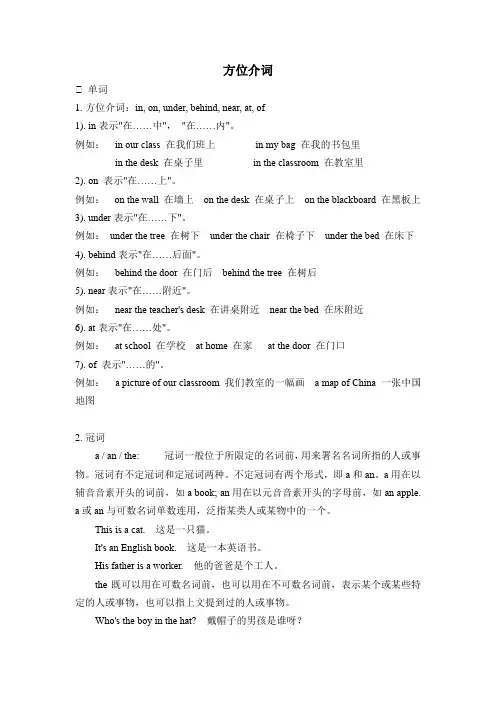
方位介词⑴单词1.方位介词:in, on, under, behind, near, at, of1). in表示"在……中","在……内"。
例如:in our class 在我们班上in my bag 在我的书包里in the desk 在桌子里in the classroom 在教室里2). on 表示"在……上"。
例如:on the wall 在墙上on the desk 在桌子上on the blackboard 在黑板上3). under表示"在……下"。
例如:under the tree 在树下under the chair 在椅子下under the bed 在床下4). behind表示"在……后面"。
例如:behind the door 在门后behind the tree 在树后5). near表示"在……附近"。
例如:near the teacher's desk 在讲桌附近near the bed 在床附近6). at表示"在……处"。
例如:at school 在学校at home 在家at the door 在门口7). of 表示"……的"。
例如: a picture of our classroom 我们教室的一幅画 a map of China 一张中国地图2.冠词a / an / the: 冠词一般位于所限定的名词前,用来署名名词所指的人或事物。
冠词有不定冠词和定冠词两种。
不定冠词有两个形式,即a和an。
a用在以辅音音素开头的词前,如a book; an用在以元音音素开头的字母前,如an apple. a或an与可数名词单数连用,泛指某类人或某物中的一个。
This is a cat. 这是一只猫。
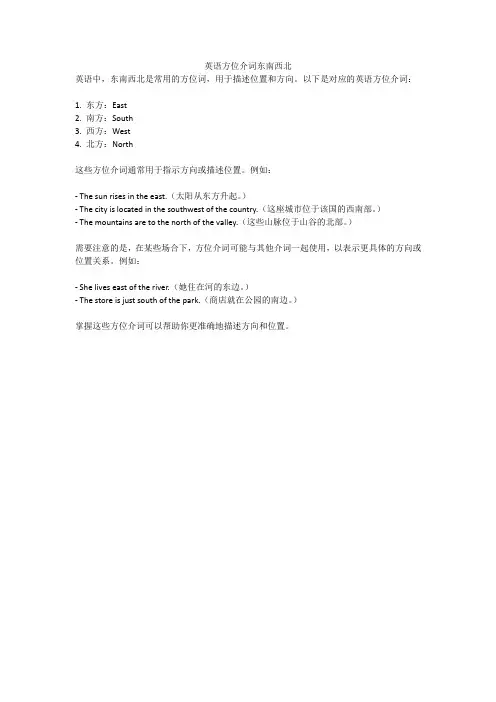
英语方位介词东南西北
英语中,东南西北是常用的方位词,用于描述位置和方向。
以下是对应的英语方位介词:
1. 东方:East
2. 南方:South
3. 西方:West
4. 北方:North
这些方位介词通常用于指示方向或描述位置。
例如:
- The sun rises in the east.(太阳从东方升起。
)
- The city is located in the southwest of the country.(这座城市位于该国的西南部。
)
- The mountains are to the north of the valley.(这些山脉位于山谷的北部。
)
需要注意的是,在某些场合下,方位介词可能与其他介词一起使用,以表示更具体的方向或位置关系。
例如:
- She lives east of the river.(她住在河的东边。
)
- The store is just south of the park.(商店就在公园的南边。
)
掌握这些方位介词可以帮助你更准确地描述方向和位置。
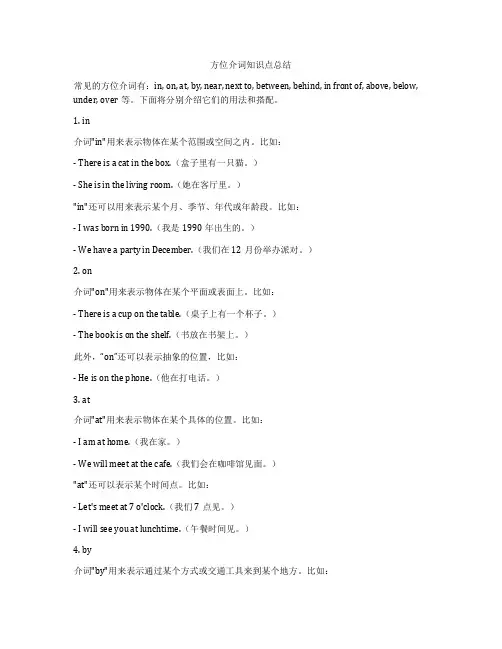
方位介词知识点总结常见的方位介词有:in, on, at, by, near, next to, between, behind, in front of, above, below, under, over等。
下面将分别介绍它们的用法和搭配。
1. in介词"in"用来表示物体在某个范围或空间之内。
比如:- There is a cat in the box.(盒子里有一只猫。
)- She is in the living room.(她在客厅里。
)"in"还可以用来表示某个月、季节、年代或年龄段。
比如:- I was born in 1990.(我是1990年出生的。
)- We have a party in December.(我们在12月份举办派对。
)2. on介词"on"用来表示物体在某个平面或表面上。
比如:- There is a cup on the table.(桌子上有一个杯子。
)- The book is on the shelf.(书放在书架上。
)此外,“on”还可以表示抽象的位置,比如:- He is on the phone.(他在打电话。
)3. at介词"at"用来表示物体在某个具体的位置。
比如:- I am at home.(我在家。
)- We will meet at the cafe.(我们会在咖啡馆见面。
)"at"还可以表示某个时间点。
比如:- Let's meet at 7 o'clock.(我们7点见。
)- I will see you at lunchtime.(午餐时间见。
)4. by介词"by"用来表示通过某个方式或交通工具来到某个地方。
比如:- He came by bus.(他乘公交车来了。
)- We can go by train.(我们可以坐火车去。
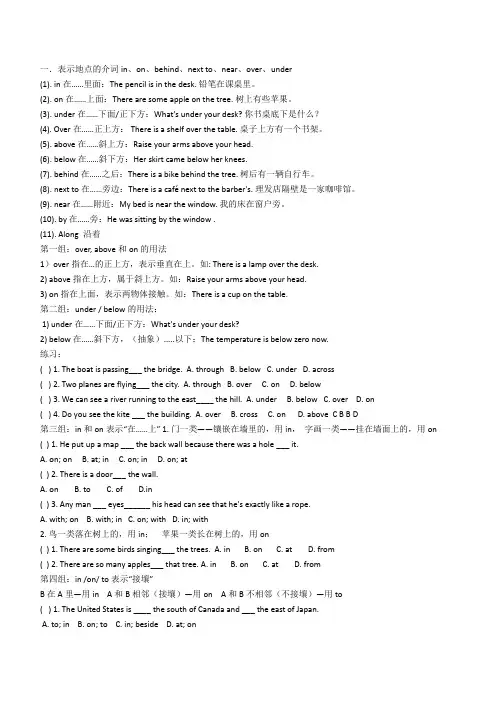
一.表示地点的介词in、on、behind、next to、near、over、under(1). in在……里面:The pencil is in the desk. 铅笔在课桌里。
(2). on在……上面:There are some apple on the tree. 树上有些苹果。
(3). under在……下面/正下方:What's under your desk? 你书桌底下是什么?(4). Over在……正上方: There is a shelf over the table. 桌子上方有一个书架。
(5). above 在……斜上方:Raise your arms above your head.(6). below 在……斜下方:Her skirt came below her knees.(7). behind在……之后:There is a bike behind the tree. 树后有一辆自行车。
(8). next to在……旁边:There is a café next to the barber's. 理发店隔壁是一家咖啡馆。
(9). near在……附近:My bed is near the window. 我的床在窗户旁。
(10). by 在……旁:He was sitting by the window .(11). Along 沿着第一组:over, above和on的用法1)over指在…的正上方,表示垂直在上。
如: There is a lamp over the desk.2) above指在上方,属于斜上方。
如:Raise your arms above your head.3) on指在上面,表示两物体接触。
如:There is a cup on the table.第二组:under / below的用法:1) under在……下面/正下方:What's under your desk?2) below 在……斜下方,(抽象).....以下:The temperature is below zero now.练习:( ) 1. The boat is passing___ the bridge. A. through B. below C. under D. across( ) 2. Two planes are flying___ the city. A. through B. over C. on D. below( ) 3. We can see a river running to the east____ the hill. A. under B. below C. over D. on( ) 4. Do you see the kite ___ the building. A. over B. cross C. on D. above C B B D第三组:in 和on表示“在……上” 1. 门一类——镶嵌在墙里的,用in,字画一类——挂在墙面上的,用on ( ) 1. He put up a map ___ the back wall because there was a hole ___ it.A. on; onB. at; inC. on; inD. on; at( ) 2. There is a door___ the wall.A. onB. toC. ofD.in( ) 3. Any man ___ eyes______ his head can see that he's exactly like a rope.A. with; onB. with; inC. on; withD. in; with2. 鸟一类落在树上的,用in;苹果一类长在树上的,用on( ) 1. There are some birds singing___ the trees. A. in B. on C. at D. from( ) 2. There are so many apples___ that tree. A. in B. on C. at D. from第四组:in /on/ to表示“接壤”B 在A里—用in A和B相邻(接壤)—用on A和B不相邻(不接壤)—用to( ) 1. The United States is ____ the south of Canada and ___ the east of Japan.A. to; inB. on; toC. in; besideD. at; on( ) 2. The man stood____the window, watching the boys playing outside.A. inB. byC. withD. to( ) 3. Japan lies____ the east of China. A. on B. to C. in D. with第五组:at, in表示“在……”at表示较小的地点。
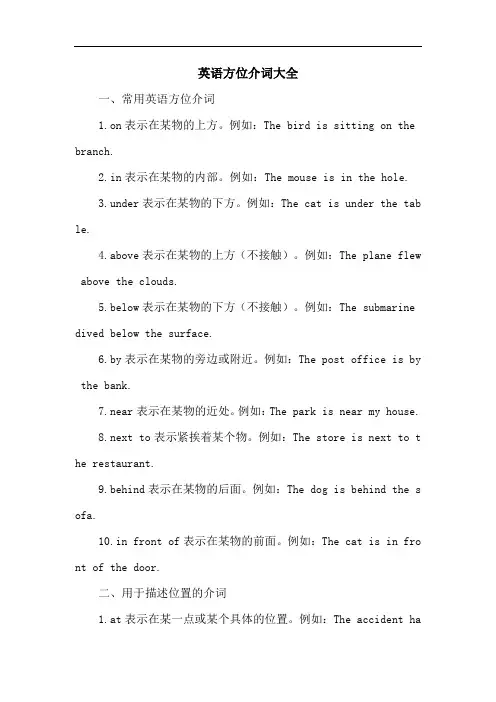
英语方位介词大全一、常用英语方位介词1.on表示在某物的上方。
例如:The bird is sitting on the branch.2.in表示在某物的内部。
例如:The mouse is in the hole.3.under表示在某物的下方。
例如:The cat is under the tab le.4.above表示在某物的上方(不接触)。
例如:The plane flew above the clouds.5.below表示在某物的下方(不接触)。
例如:The submarine dived below the surface.6.by表示在某物的旁边或附近。
例如:The post office is by the bank.7.near表示在某物的近处。
例如:The park is near my house.8.next to表示紧挨着某个物。
例如:The store is next to t he restaurant.9.behind表示在某物的后面。
例如:The dog is behind the s ofa.10.in front of表示在某物的前面。
例如:The cat is in fro nt of the door.二、用于描述位置的介词1.at表示在某一点或某个具体的位置。
例如:The accident happened at the intersection of two roads.2.in表示在一个较大的范围内或某个封闭的空间内。
例如:She lives in the city center.3.on表示在一个物体的表面或上方。
例如:The book is on the table.4.under表示在另一个物体的下方或内部。
例如:The box cont ains a book,and the book is under the lid of the box.5.above表示在一个物体的上方,但不一定紧挨着该物体。
方位介词英语
方位介词是指用来表示方向、位置、移动等概念的介词。
在英语中常用的方位介词包括in、on、at、under、over、between、among、behind、beside、with等。
这些方位介词在句子中的使用需要根据具体情境来确定,例如:
- In表示在一个封闭的空间内或时间段的内部,如in the room、in the morning。
- On表示在一个平面或表面上,如on the table、on the wall。
- At表示在某个地点或时间点,如at the park、at 2 o'clock。
- Under表示在某物的下方,如under the bed、under the tree。
- Over表示在某物的上方,如over the bridge、over the clouds。
- Between表示在两个物体或位置之间,如between the two chairs、between the river and the mountain。
- Among表示在多个物体或位置之间,如among the flowers、among the crowd。
- Behind表示在某物的后面,如behind the door、behind the car。
- Beside表示在某物的旁边,如beside the river、beside the bookshelf。
- With表示伴随或一起,如with my friends、with a cup of tea。
在学习和使用方位介词时,需要注意它们的用法和意义,并且要根据具体语境进行正确的运用。
方位介词用法总结方位介词是一类用于表示地点、位置、方向等概念的介词。
在英语中,常见的方位介词有in、on、at、under、below、above、over、to、from、between、among等。
它们的不同用法和意义有所区别,下面对这些方位介词的常见用法进行总结和解释。
1. in:表示"在……之内",通常用于地点、国家、城市等概念上,例如:- He is in the room.(他在房间里。
)- She lives in London.(她住在伦敦。
)2. on:表示"在……之上",可以用于表示在物体表面、建筑物上、车辆上等地方,例如:- The book is on the table.(那本书在桌子上。
)- I saw him on the bus.(我在公交车上见到他。
)3. at:表示"在……处",可以用于点、地方或事件等的描述上,例如:- He is waiting for you at the bus stop.(他在公交车站等你。
)- We had dinner at a fancy restaurant last night.(昨晚我们在一家高档餐厅吃饭。
)4. under:表示"在……之下",可以用于表示物体的位置或遮蔽物下等情况,例如:- The cat is sleeping under the table.(猫睡在桌子下面。
)- The book is under the bed.(书在床下。
)5. below:表示"在……以下",可以用于比较高度、水平或等级等的描述上,例如:- The temperature dropped below freezing last night.(昨晚气温降到了冰点以下。
)- He ranks below his brother in the class.(他在班里的排名在他弟弟之下。
20个常用英语表方位介词常用的20个英语表方位介词有:in、on、at、under、over、above、below、in front of、behind、along、across、around、near、next to、by、beside、towards、inside、outside、to等等。
1、in:在……内部;在……里面的意思;What is in the box?盒子里有什么?2、on:在某物的上面,两者互相接触;My books are on that table.我的书在那张桌子上。
3、at:在……处,一般指较小的比较具体的地点;He isn't at school.He is at home.他不在学校,他在家。
4、under:表示在某物垂直的正下方,两者之间不接触;My cat is under my chair.我的猫在我的椅子下。
5、over:一种垂直悬空的上下关系,即“在正上方”,是under的相对反义词;Is there any bridge over the river?6、above: 在......上方,相对于另一者在上方7、below: 在......上方,相对于另一者在上方,是above的相对反义词;8、in front of:在……的前面,正好与behind相反;There are some big trees in front of our classroom. 我们教室前面有几棵大树。
9、behind:在某物体的后面。
The broom is behind the door.笤帚在门后。
10、along:沿着……,顺着……I'm walking along the river.我正沿河而行。
11、across:从一边到另一边,在……那边。
There are many trees across the river.河对岸有很多树。
12、around:“围绕,绕着”The house is built around a central courtyard.这房子是围绕着中央的庭院而建的。
方位介词英语大全on 在……上面on the table 在桌子上on the wall 在墙上in 在里面in the kitchen 在厨房里in the mountain 在山里in Singapore在新加坡under 在……下面under the chair 在椅子下面under the tree在树下in front of 在……前面in front of the house在房子前面in front of the car 在车前面behind在……后面behind the mall 在商场后面behind my house在我家后面in the front of 在……(内部)前面in front of the house在房子前面in front of the car 在车前面at the back of(1) 在……的后面(范围之外),相当于behindThere is a little garden at the back of the house. 房屋后有个小花园。
We planted some trees at the back of the school. 我们在学校后面种了些树。
(2) 在……的后部(范围之内)There is a little room at the back of the house. 房屋后部有个小房间。
The index is at the back of the book. 索引在书末尾。
注:用于此义,不能用behind 换。
in the back of 在……后部He sat in the back of the car. 他坐在小汽车后部。
注:美国英语中有时可只用(in) back of 来表示以上意思。
My home lies (in) back of the school. 我家就在学校后面next to=near=by 在旁边/ 在附近/ 毗邻next to the post office在邮局旁边near the cinema在电影院附近by the river 紧邻这条河beside在旁边,在……旁边,在……近旁beside the stove 在炉子旁边stand beside her mother 站立在她妈妈旁边set a chair beside him and sat down. 在他旁边放一把椅子between 在……和……中间;介于……(两者)之间the border between Sweden and Norway 瑞典和挪威之间的边界between 6 p.m. and 8 a.m. 下午6点到早晨8点间between the ages of 5 and 16 5到16岁之间children between the ages of 5 and 16 5到16岁的孩子between the desk and the wall 在桌子和墙壁之间(的缝隙)among 在……之间(三者及以上)among the trees 在树木之间above =over 在上方(不接触)over the mountain top在山顶above your head 在你的头上面below 在下方(不接触)below the surface of the water 水中below this line 在这条线下面remained below freezing 保持在冰点以下below the desk在书桌下面opposite在……对面opposite the street 在街对面opposite the hotel在宾馆对面I sat opposite him during the meal (= on the other side of the table) .席间我坐在他的对面。
知识卡片:定义:方位介词:表示事物存在的方向和位置的介词叫方位介词。
注意事项:1.不能单独使用2.通常和后面的名词或代词构成介词短语。
即:方位介词(in/on/under)+定冠词the或形容词性物主代词等+名词用法:方位介词in、on、under的用法单词意义例句In 表示“在...中;在...里”,指某个空in our clsss在我们班里间的内部。
in my bag在我的包里on the wall在墙上on 表示“在...上”,指一个人或物在另一个人或物的上面。
on the floor在地板上under the chair在椅子下under 表示“在...下”,常指一个人或物在另一个人或物的下面。
under the tree在树下例题1.----Where is the blackboard?----It’s _________ the classroom.A.onB. inC. withD. under2.-----Where are the cat?----- It’s ___________ the boxA.onB. inC. withD. under3.----- Where is my box?------ It’s _________ the desk.A.onB. inC. withD. under4. ----- Where is my box?---- It’s _________ the chair.A.onB. inC. withD. under 练习:1.----Where's the cat ?---- It's ________ the desk .A.onB. inC. withD. under2. ----- Where's the ball ?---- It's ________ the chair .A.onB. inC. withD. under3. ----Where's the monkey ?---- It's ________ the box .A.onB. inC. withD. under4. The key are __________ _________ ____________.(在椅子下面)5.My English book is _______ _______ _________(在沙发上)6. The schoolbag is ________ ________ _______ (在我玛丽的房间里)总结:测评:1.It’s ______ the chair.2.The apple is _____the box3.It’s ________ the hat.4.It’s ________ the desk.作业1.-----Where is your brother?------ He is _______ the library.A.onB. inC. withD. under2. -----Where are your friends?------ They are playing _______ the playground.A.onB. inC. withD. under 二.用介词in,on或under填空.1. The map is _____ my room, ____ the wall.2. The hat is ____ your head.3. His bike is _______ the tree.4. Some birds are _____ the tree, and some apples are ____ it, too.5. The students are _____ the classroom.。
介词短语介词是一种用来表示词与词, 词与句之间的关系的词。
在句中不能单独作句字成分。
介词后面一般有名词代词或相当于名词的其他词类,短语或从句作它的宾语。
介词和它的宾语构成介词词组,在句中作状语,表语,补语,定语或介词宾语。
at ,in, on, toat (1)表示在小地方; (2)表示“在……附近,旁边”in (1)表示在大地方; (2)表示“在…范围之内”。
on 表示毗邻,接壤to 表示在……范围外,不强调是否接壤He arrived at the station at ten.He is sitting at the desk.He arrived in Shanghai yesterday.Jiangsu lies in the east of China.Russia live on the north of China.Fujian is to the south of Jiangsu Province.2)above, over, on 在……上above 指在……上方,不强调是否垂直,与below相对;over指垂直的上方,与under相对,但over与物体有一定的空间,不直接接触。
on表示某物体上面并与之接触。
The bird is flying above my head.There is a bridge over the river.He put his watch on the desk.3)below, under 在……下面under表示在…正下方below表示在……下,不一定在正下方There is a cat under the table.Please write your name below the line.(1. B 2. C 3. B 4. A 5. A 6. C 7. B 8. D )1.After John’s father died, John ______A. decided to get married firstB. decided to pay for the farm firstC. did not know what to doD. decided never to get married2. When Sally said she thought John wrote the poem himself, he ______.A. said he wrote it himselfB. said he just learned it from a bookC. said nothingD. knew his wife was laughing at him3. John could speak the poems because ______.A. he had learned them before they got marriedB. he learned the poems from an old bookC. he wrote them himselfD. his friend told him4. When Sally heard the poems, ______.A. she was happyB. she was sadC. she did not like JohnD. she was angry5. John spoke the words of poems to Sally ______A. to make her happyB. to show how clever he wasC. to teach her how to write poemsD. to make her love him6. When Joanna grew up, ______.A. she wanted to become an engineerB. she wanted to stay on the farmC. she wanted to teach English poemsD. she wanted to write poems7. When Sally learned about the truth, ______.A. she was very angryB. she decided to keep it a secret from JohnC. she decided to ask John about itD. she did not love John any more8. From the text, we can see that ______.A. at last John knew that his wife had learned the truth about his poemsB. his wife was sure that he had written the last poem himselfC. John learned his last poem to his wife from the bookD. the poem was the first and only poem he had made himself巧用介词表方位当我们在谈论物品的位置关系时,常用下列表达方式:1. —— Where's Sandy's sweater? 桑迪的毛衣在哪儿?—— It's on the bed. 在床上。
2. —— Is the football under the chair? 足球在椅子下面吗?—— Yes, it is. 是的,是在椅子下面。
3. —— Is Shenzhen near Taiwan Or Hong Kong? 深圳在台湾附近还是在香港附近?—— It's near Hong Kong. 在香港附近。
(1) on 表示在某物的上面,指与某物体相接触。
如:The map of China is on the wall. 中国地图挂在墙上。
His coat is on the chair. 他的上衣在椅子上。
(2) under 表示在某物垂直的正下方,两者之间不接触。
如:My pen is under the desk. 我的钢笔在桌子下。
(3) behind 表示在某物的后面。
如:There is a tree behind the house. 房子后面有棵树。
(4) in 表示在场所、地点或位置里,意为―在……之内‖、―在……里面‖。
如:Your pencil is in the pencil-box. 你的铅笔在铅笔盒里。
Nanjing is in Jiangsu Province. 南京在江苏省。
(5) in front of 表示―在……的前面‖,与behind 恰好相反。
如:My sister stands in front of my father. 我妹妹站在我父亲前面。
(6) near 表示在某物的附近,意为―接近,靠近‖。
如:My house is near the lake. 我的房子位于湖畔。
(7) over 表示在某物的垂直正上方,与under 正好相反。
如:The light is over the desk. 灯在课桌的正上方。
[ 问题爷爷] 魔力宝贝,―书在桌子上‖一句译为英文时是― The book on the desk. ‖吗?[ 魔力宝贝] 简直大错特错。
凡是in 、on 、under 、near 、behind 、in front of 、over 等介词后面加名词表示方位时,不要忘掉动词― be ‖。
上句应说成:The book is on the desk. 这与汉语的表达形式有所不同。
[ 问题爷爷] 魔力宝贝,你真了不起,所有难题你都能迎刃而解。
所谓―活到老,学到老(It's never too old to learn. )‖,问题爷爷真是跟你学到了不少东西。
[ 魔力宝贝] 谢谢夸奖。
同学们课后有时间一定要把已学的表方位的介词短语归纳一下,集中记忆将会助你学习成功。
() 1. China lies _______ the east of Asia and ______ the north of Australia.A. to; toB. in; toC. to; inD. in; on() 2. ______ the afternoon of March 8, the women in the city had a big party.A. ToB. InC. AtD. On() 3. We all agree _______ you. Let’s start at once.A. toB. forC. withD. on() 4. Where’s Lily? We are all here _______ her.A. besidesB. aboutC. exceptD. with() 5. Does your father go to work, _______ foot or _______ bike?A. on; withB. with; onC. by; onD. on; by() 6. Lucy was _______ duty yesterday, but she forgot to clean the classroom.A. inB. onC. atD. of() 7. Timmy goes to school _______ every day. It’s 5 minutes’ walk from his home to school.A. in a busB. by planeC. on footD. by boat() 8. Mum, today is Mother’s Day. Mike an d I want to invite you to have dinner ___ ____ us at Shanghai Restaurant, which is famous _______ its seafood.A. with; ofB. with; forC. for; toD. to; for() 9. He has got a chair to sit _______, but nobody to talk _______.A. on; toB. /; withC. on; /D. /; to() 10. Jack has studied Chinese in this school _______ the year of 2000.A. sinceB. inC. onD. by() 11. –How are you going to the train station to meet your aunt?--I’m going there _______ my car.A. byB. inC. toD. on() 12. Andy often helps her mother ________ the housework on Sunday afternoon.A. toB. withC. forD. of() 13. –You’d better not go out now. it’s raining.--It doesn’t matter. My new coat can keep _______ rain.A. inB. ofC. withD. off()14. English is widely used ________ travelers and business people all over the worldA. toB. forC. asD. by() 15. My sister usually thinks _______ her own language first. Then she turns her w ords into English.A. byB. inC. withD. through() 16. –It’s kind _______ you to come to see me.--It’s a pleasure. You were so kind _______ me.A. of; withB. for; withC. of; toD. for; to() 17. –Is the manager in?--Sorry, he is out. But he will be back _______ three o’clock.A. inB. onC. untilD. before() 18. _______ the age of fifteen, she had written scores of articles for a newspaper.A. AtB. BeforeC. SinceD. By() 19. In China, the price of TV sets has been reduced ________ 30% in the last three years.A. onB. byC. withD. for() 20. When you called on me, I was _______ a visit to Mr Smith.A. onB. atC. inD. to() 21. –Bob, you are wanted _______ the phone.–Thanks a lot.A. onB. byC. ofD. for() 22. The soil is made _______ the dead leaves of the trees.A. up ofB. ofC. fromD. by() 23. I didn’t have any breakfast _______ a cup of milk.A. besidesB. except forC. exceptD. for() 24. We’re sure you’ll be famous _______ a writer before long.A. asB. forC. withD. by() 25. The writer often sat up far into the night working _______ a new novel.A. forB. onC. withD. in() 26. You look tired. ________ working indoors you should be out for a walk.A. Ahead ofB. Instead ofC. In front ofD. In spite of() 27. You must stand _______ line when you are waiting _______ a bus.A. on; inB. in; forC. in; onD. on; for() 28. Man landed on the moon in 1969 for the first time. Have you ever heard ____ __ it?A. onB. toC. ofD. from() 29. It’s very nice ______ you to get me two tickets _______ the World Cup.A. for; ofB. of; forC. to; forD. of; to() 30. The woman feels worried _______ her sick baby.A. forB. toC. onD. about() 31. –What do you think of the report on the UFOs?Great! Many students were interested in it and they kept on standing ______ the end of t he meeting.A. untilB. inC. atD. by() 32. Have you got any books _______ science?A. atB. aboutC. ofD. in() 33. She likes reading _______ many different subjects.A. ofB. atC. onD. in() 34. Mr Wang is very strict. His students are afraid _______ him.A. atB. ofC. aboutD. to() 35. This story happened _______ the last few years.A. atB. sinceC. duringD. for() 36. We should do something to stop sandstorms ______ happening again and again.A. fromB. onC. byD. to() 37. China became a WTO member _______ December 11th , 2001.A. onB. inC. atD. of() 38. There’s a smile on her face. I think she’s _______ my work.A. sorry forB. worried aboutC. pleased withD. afraid of答案:1—5 BDCCD 6—10 BCBAA 11—15 BBDDB 16—20 CDABA 21—25 ACCAB 26—30 BBCBD 31—35 ABCBC 36—38 AAC。